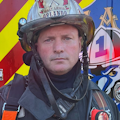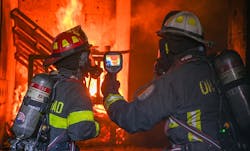Since the fire service began to handle emergencies, a “someone” has been in charge of the incident, to lead the people who help to solve the problem. Typically, the incident commander (IC) is educated in a variety of topics and has served for a considerable amount of time. Unfortunately for the experience value, skills that are learned and reinforced by emergency alarms are limited and inconsistent, because call volume is small compared with the other attended needs of the agency.
One thing that’s fairly consistent is the reduced amount of required training for ICs. In the case of most organizations, once a person is promoted to chief officer, that person’s skills-improvement journey is finished. This might not have been so problematic in years past when incidents were frequent enough and consistent enough to fortify command skills and ability. However, as fire safety has improved, frequency has reduced, and the rigidity of consistent, common calls gave way to a wide breadth of types of incidents.
To these points, advanced and recurrent training as well as skills application must be established to ensure the best level of potential ability. Without mastery of skill, poor performance is a considerable potential, with the consequences being severe. Unfortunately, the line firefighting personnel usually suffer those consequences.
This leads to the need for command competency—not just a basic lecture program or a one-day tabletop exercise but genuine, realistic training. To this, numerous parts must be employed to enable the commander to reach functional competency: realistic expectations, honest evaluation and improvement, and follow-up and reevaluation.
Training reminds
To achieve realistic expectations, command officers must engage in hands-on training with their personnel. I know that the argument in return is, “We don’t have enough time to do all this,” and my response to you is that you are correct. That said, part of this is poor alignment of priorities, and another part is poor time budgeting. Both can and should be improved. Some of the busiest response chiefs who I know still accommodate time to train with their personnel. Yes, some days will be more congested than others, but practical training with crews on a common basis enables commanders to remember how challenging “the job” can be.
Some of these reminders help us to keep a frame of mind that ensures that we understand a crew’s capabilities, such as how quickly it deploys the primary attack line, establishes a water supply, ladders a building, gets a search done, repositions apparatus at a scene, etc. It also helps us to remember how hot or cold conditions affect operational times, how long personnel truly can operate on air, and how many tasks reasonably can be achieved with the number of personnel that’s assigned.
Tactical alignment
Tactics discussions should be held—not just one on one but with the crew at the table and with other crews.
Don’t limit the discussions to a single company officer; enlist several. If nothing else, everyone can share various ways that tasks can be done, understand how some make their decisions and, if necessary, set a common operating picture to ensure that each company does what’s expected of it. Even if you have standard operating procedures, Blue Card Command or other command procedures, you will see the variety that exists among officers of the same organization, of the same battalion and with the same training division. This is where a commander must ensure alignment for tactical priorities, strategic goals, for communication considerations, and for overall expectations from you to them and them to you.
Improving communication, forecasting crew progress, and realizing what the crew can achieve and how long it will take (all obtained intentionally or subliminally) are crucial in forecasting the fire’s progress and what are realistic tactics. It’s imperative that ICs be three steps ahead, anticipating needs and preparing Plan H when Plans A through G don’t achieve the results that are needed.Honest evaluation
While partaking in physical and discussion-based training, command officers should note personnel’s performance for the good points, where improvements can be made and where deficiencies exist. As well, take note of equipment issues and policy/response/procedure issues for their improvement. Realize what immediate corrections can be made by you and the crew, what needs department/administration support, what is financially achievable and what needs planning for improvement over time. Examples of the latter can include changing an antiquated hoseload that prevents the crew from meeting its needs; reviewing who is assigned what task on a fireground; and determining what personal fitness levels can be improved. Realize that all of the matters might not be achieved, but keep in mind, a something is better than a nothing.
Set goals
Because there are only so many topics that “indoor” and hands-on training can cover, keep training palatable. Set goals that are SMART (specific, measurable, achievable, realistic and timely). I recommend setting two easy wins, a moderate goal to work at and a long-term improvement goal. The easy wins give energy to the crews that are involved. A moderate goal helps to define benchmarks and, in some cases, who are your better task-managers. A long-term goal can be chipped away at, with buy-in from others who might end up being the ones to see the project to fruition.
The changes to choose first might be those that are the most impactful, the least costly or the easiest to gain support of.
Take ownership
Command officers who expect their training division to teach them all that they should know for their job will fail. There simply aren’t enough hours in the day for the training division to cover all of the points that are needed. Command officers must take ownership of personal deficiencies and strive to eliminate them.
Some mechanisms are:
- Attend conferences and courses that teach command skills or that allow you to perform in scenarios. Self-study of fire service chief-level educators, such as Anthony Avillo, Vinnie Dunn, Anthony Kastros, John Salka Jr. and Jerry Tracy, helps you to learn or reinforce the multitude of command-relative needs.
- Attend every multicompany drill, to work with the crews and to provide radio traffic that’s commensurate to an event.
- Develop the first few minutes of an incident, to have first-in companies give arrival reports, which lead you to direct operations, respective to your agency’s operational policy.
My favorite option is to create a peer-to-peer training group within the organization or region, to help to facilitate training scenarios that reinforce command skills and, even better, to challenge command officers to operate at large-scale incidents. Utilize photo- and video-based simulation systems to create the visual but also use radios and scripts (with the ability to ad-lib) to allow the commander to be given situations to command and interact with. With the commonplace use of internet communication platforms, such as Teams and Zoom, members can be in their respective offices watching the same scenario and reacting by radio. That said, meeting in person on a common basis allows for more discussion.
At the highest level
There are only three things that we don’t know before we respond to a fire—what building it’s in, where in the building the fire is happening and where the victims are. As a responsible fire service, we should know everything about our job as best as possible before the alarm, so that those three things are the only facts that we need to obtain. How to be command competent should be our expertise.
In critical situations, the community and personnel trust that command officers are ready. If we fail, it’s they who suffer the most.
About the Author

Walt Lewis
Walt Lewis has been in the fire service since 1990 and currently serves as an assistant chief for the Orlando, FL, Fire Department. He has been involved with instructing and presenting programs at a variety of fire service venues and institutions since 1999.

